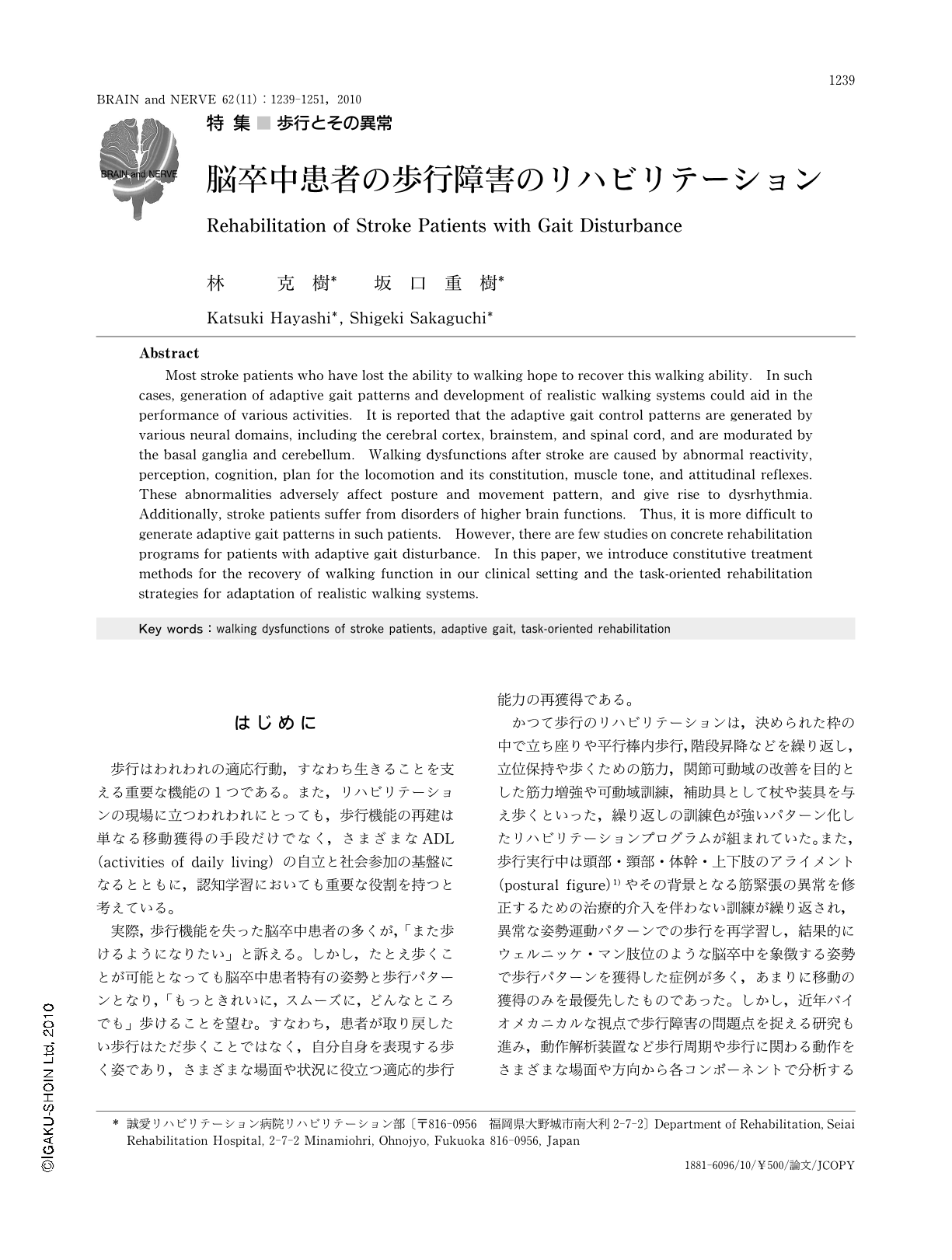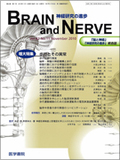Japanese
English
- 有料閲覧
- Abstract 文献概要
- 1ページ目 Look Inside
- 参考文献 Reference
はじめに
歩行はわれわれの適応行動,すなわち生きることを支える重要な機能の1つである。また,リハビリテーションの現場に立つわれわれにとっても,歩行機能の再建は単なる移動獲得の手段だけでなく,さまざまなADL(activities of daily living)の自立と社会参加の基盤になるとともに,認知学習においても重要な役割を持つと考えている。
実際,歩行機能を失った脳卒中患者の多くが,「また歩けるようになりたい」と訴える。しかし,たとえ歩くことが可能となっても脳卒中患者特有の姿勢と歩行パターンとなり,「もっときれいに,スムーズに,どんなところでも」歩けることを望む。すなわち,患者が取り戻したい歩行はただ歩くことではなく,自分自身を表現する歩く姿であり,さまざまな場面や状況に役立つ適応的歩行能力の再獲得である。
かつて歩行のリハビリテーションは,決められた枠の中で立ち座りや平行棒内歩行,階段昇降などを繰り返し,立位保持や歩くための筋力,関節可動域の改善を目的とした筋力増強や可動域訓練,補助具として杖や装具を与え歩くといった,繰り返しの訓練色が強いパターン化したリハビリテーションプログラムが組まれていた。また,歩行実行中は頭部・頸部・体幹・上下肢のアライメント(postural figure)1)やその背景となる筋緊張の異常を修正するための治療的介入を伴わない訓練が繰り返され,異常な姿勢運動パターンでの歩行を再学習し,結果的にウェルニッケ・マン肢位のような脳卒中を象徴する姿勢で歩行パターンを獲得した症例が多く,あまりに移動の獲得のみを最優先したものであった。しかし,近年バイオメカニカルな視点で歩行障害の問題点を捉える研究も進み,動作解析装置など歩行周期や歩行に関わる動作をさまざまな場面や方向から各コンポーネントで分析することや,脳卒中患者の歩行障害が中枢神経系の制御の障害として捉えられ,直接歩行に関わる筋骨格系に重点を置くだけでなく,それらを制御する中枢神経系に目が向けられるようになってきた。歩行における中枢性運動パターン発生器(central pattern generator:CPG),歩行中枢の発見2-4)や皮質における高次脳機能と歩行への関与,さらに調節系としての大脳基底核や小脳など,中枢神経系の歩行への役割が少しずつ解明され,さらに中枢神経損傷患者がリハビリテーションにより,中枢神経系内の可塑的な変化による効果が期待されることが明らかにされつつある5-8)。そのため,歩行の背景となっている高次脳機能をも考慮し,中枢神経系疾患に対する神経リハビリテーションの視点に立った歩行障害のリハビリテーションを実践することが重要となってきた9-12)。
Abstract
Most stroke patients who have lost the ability to walking hope to recover this walking ability. In such cases,generation of adaptive gait patterns and development of realistic walking systems could aid in the performance of various activities. It is reported that the adaptive gait control patterns are generated by various neural domains,including the cerebral cortex,brainstem,and spinal cord,and are modurated by the basal ganglia and cerebellum. Walking dysfunctions after stroke are caused by abnormal reactivity,perception,cognition,plan for the locomotion and its constitution,muscle tone,and attitudinal reflexes. These abnormalities adversely affect posture and movement pattern,and give rise to dysrhythmia. Additionally,stroke patients suffer from disorders of higher brain functions. Thus,it is more difficult to generate adaptive gait patterns in such patients. However,there are few studies on concrete rehabilitation programs for patients with adaptive gait disturbance. In this paper,we introduce constitutive treatment methods for the recovery of walking function in our clinical setting and the task-oriented rehabilitation strategies for adaptation of realistic walking systems.

Copyright © 2010, Igaku-Shoin Ltd. All rights reserved.


